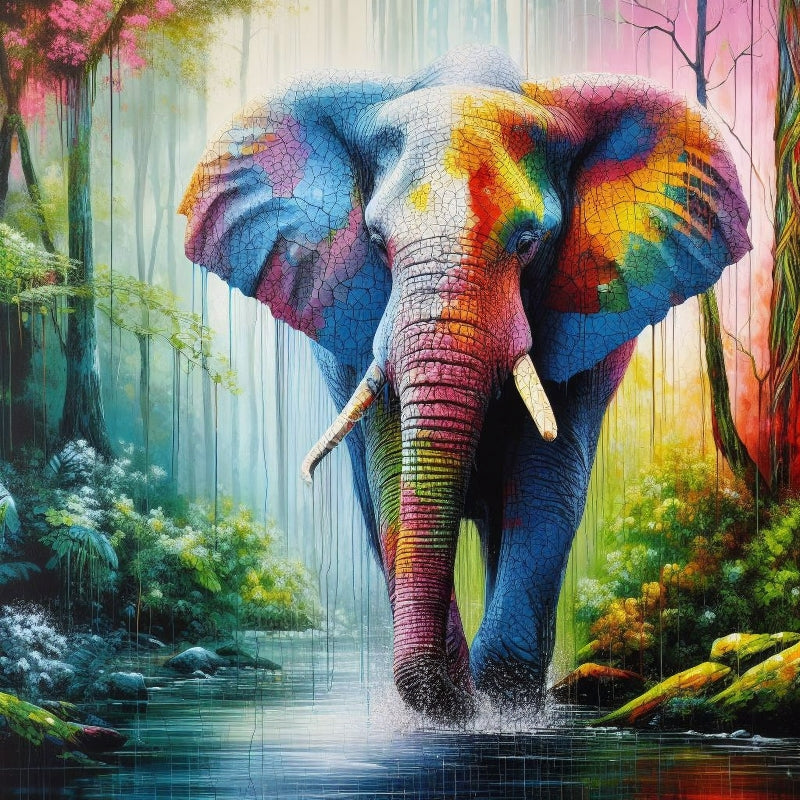
Top 10 Interesting Facts About Indian Elephants
Share
Indian elephants (Elephas maximus indicus), a subspecies of the Asian elephant, are among the most magnificent and intelligent creatures on the planet. Revered in many cultures, these gentle giants play a crucial role in their ecosystems and are vital to the cultural heritage of India. Despite their importance, Indian elephants face numerous threats, including habitat loss and poaching. This blog post highlights ten fascinating facts about Indian elephants, drawing from scholarly articles and authoritative sources to provide a deeper understanding of these incredible animals.
- Endangered Status
Indian elephants are classified as Endangered by the International Union for Conservation of Nature (IUCN). Their populations have drastically declined over the years due to habitat destruction, poaching for ivory, and human-elephant conflict. Current estimates suggest that fewer than 50,000 Indian elephants remain in the wild, primarily confined to fragmented habitats across India, Nepal, and parts of Southeast Asia.
- Impressive Size and Weight
Indian elephants are among the largest land mammals, with adult males weighing between 4,500 to 11,000 pounds (2,000 to 5,000 kg) and standing about 8 to 10 feet (2.4 to 3.1 meters) tall at the shoulder. Females are generally smaller than males. The largest recorded Indian elephant was an astonishing 11.3 feet tall at the shoulder. Their massive size not only makes them awe-inspiring but also plays a significant role in their ecological impact.
- Unique Trunk Structure
The trunk of an Indian elephant is one of its most distinctive features. It contains over 150,000 individual muscles and has no bones, allowing for incredible flexibility and strength. The trunk is used for various purposes: from feeding and drinking to social interactions and communication. Interestingly, the trunk has a single finger-like projection at its tip, which enables them to grasp small objects with precision.
- Herbivorous Diet
Indian elephants are herbivores with a diverse diet that includes grasses, leaves, fruits, bark, and roots. They can consume up to 330 pounds (150 kg) of vegetation per day. Their foraging habits make them essential "ecosystem engineers," as they help maintain the health of their habitats by clearing vegetation and creating paths that benefit other species.
- Social Structure
Elephants are highly social animals that live in matriarchal herds typically led by an older female. These herds usually consist of related females and their young, while adult males tend to leave the herd upon reaching maturity. The strong family bonds within elephant herds are vital for raising calves and ensuring their survival in the wild.
- Communication Skills
Indian elephants possess sophisticated communication skills that include vocalizations such as trumpets and rumbles as well as non-verbal cues like body language and touch. They can produce low-frequency sounds called infrasound, which can travel long distances—up to 10 miles—allowing them to communicate with other elephants over vast areas. This ability is crucial for maintaining social bonds within herds.
- Long Lifespan
In the wild, Indian elephants can live up to 60-70 years, although their lifespan may be shorter in captivity due to various factors. Their longevity allows them to accumulate knowledge about migration routes and resource locations, which is essential for the survival of their herds.
- Cultural Significance
In Indian culture, elephants hold immense significance and are often associated with various deities. The most famous representation is Lord Ganesha, who is depicted with an elephant's head and symbolizes wisdom, prosperity, and good fortune. Elephants are also featured in festivals such as Ganesh Chaturthi and are used in traditional ceremonies across India.
- Conservation Efforts
Numerous organizations work tirelessly to protect Indian elephants through conservation programs aimed at habitat preservation, anti-poaching initiatives, and community engagement efforts. These programs focus on mitigating human-elephant conflict by promoting coexistence strategies that benefit both local communities and elephant populations.
- Ecological Importance
As megaherbivores, Indian elephants play a critical role in shaping their ecosystems. Their feeding habits help maintain grasslands and forests by preventing overgrowth of certain plant species. Additionally, their dung serves as a natural fertilizer that promotes nutrient cycling within ecosystems.
By creating clearings in dense vegetation through their foraging activities, they facilitate growth opportunities for other plant species.
Conclusion
Indian elephants are remarkable creatures that embody strength, intelligence, and social complexity. As endangered animals facing numerous threats from human activities, it is crucial to raise awareness about their plight and support conservation efforts aimed at protecting these majestic beings.
Understanding these ten fascinating facts about Indian elephants not only deepens our appreciation for them but also highlights the importance of preserving their habitats for future generations. By fostering coexistence between humans and elephants through sustainable practices and education initiatives, we can ensure that these gentle giants continue to roam the forests of India for years to come. This blog post provides a comprehensive overview of Indian elephants while emphasizing their ecological significance and conservation needs based on scholarly articles from reputable sources like Critter Squad, World Land Trust, Kaziranga National Park, and SeaWorld.
Citations:
[1] https://www.crittersquad.com/fact-sheets/indian-elephant-fact-sheet/
[2] https://www.worldlandtrust.org/species/mammals/asian-elephant/
[3] https://www.kaziranganationalpark.com/elephant.htm
[4] https://seaworld.org/animals/facts/mammals/asian-elephant/
